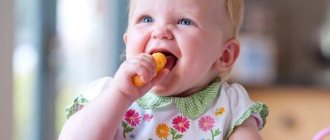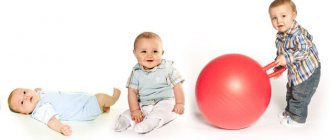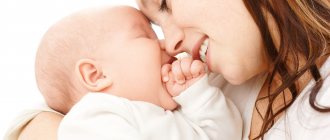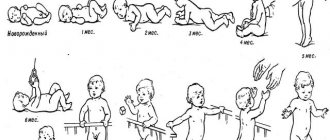In some cases, parents may notice that their newborn babies squint. This condition of a child is considered normal by about six months of age. This phenomenon has a justification, which lies in the inability to use both eyes at the same time when examining objects. If the situation continues when the baby is 6 months old, Parents should consult a doctor
.
In some cases, parents may feel that the child’s eyes are squinting due to the fact that he has a large distance between the eyes with a wide bridge of the nose.
To check your assumptions, just shine a flashlight into your baby’s eyes. In the absence of strabismus, the reflections of light will be located in the same places in both eyes.
Features of hearing development
The baby already has hearing in utero, at 16-17 weeks. Experiments prove that children hear both voices and music perfectly, and after birth the phenomenon of “recognition” of melodies or even poetry is observed. "Recognition" usually manifests itself in animated movements. Most quickly, the baby begins to recognize his mother and the timbre of her voice, because it is this voice that he is most accustomed to.
In the first days of life, children notice only high volume (and do not pay attention to the TV or vacuum cleaner, to low-volume conversations and other not very pronounced “signals”). Therefore, the question of whether newborn children hear can be answered this way: their hearing is fine, they just do not respond to all stimuli.
Rattles and other objects that make not too quiet sounds, as well as light clapping of your hands near the ear, are a good way to test your baby's hearing. The main thing is not to overdo it and not to scare the baby. When talking to him, change the pace, volume of speech and intonation and you will see:
- movements of arms and legs;
- changes in facial expression;
- movements of the head or “search” with the eyes;
- flinching or freezing.
Crying or convulsive movements usually appear when sounds frighten the child, for example, an unfamiliar voice nearby, loud conversation, and especially screaming. Do not be alarmed by the baby’s “inappropriate” (too sharp) reaction, he just has very heightened sensitivity, and this is normal. At least in the first month, all family members and guests should behave more quietly, and direct communication with the baby should be calm and even.
So, when do newborns begin to hear? Of course, right away, but the child begins to turn his head consciously, looking for sources of sounds, by the end of the third month. If he is very passionate about something, he will not react to any stimuli. This is also normal.
Talk to your baby more, sing or play children's songs, tell poems and short fairy tales. This, in addition to the development of hearing, lays the foundation for the formation of speech.
When does a child start talking?
Already at the age of one month, the baby begins to coo in response to his parents. A one-year-old child understands speech, pronounces individual syllables and simple words (mom, give, drink). Next, children’s vocabulary is replenished, so by 15-18 months they are already actively speaking. If your baby at the age of 2-3 years speaks only a couple of words, then this situation should alert you. In this case, it is worth contacting a speech therapist to identify a possible cause - problems with the speech apparatus, short frenulum on the tongue, poor hearing. Sometimes a consultation with a neurologist is required if the child’s cells in the part of the brain responsible for speech are slowly maturing.
Helping kids learn to speak
All caring parents should strive to develop speech skills in children from an early age. Always voice your actions aimed at the baby (Mom washes Tanya’s hands. Mom puts on Sasha’s pants). Show your child surrounding objects and name them. Ask him where his favorite toy, tree, brother is.
After a year, the child not only understands, but also performs the actions indicated by the adult. Ask the baby to bring a toy, go together to get dressed, wash, etc. Be sure to read books to him and sing a song. When he starts talking, learn poetry with him. Show pictures and name the objects depicted several times.
Please note that words must be pronounced clearly and distinctly. Never coax a child who is learning to talk. Remember that the baby understands simple sentences, but does not pay attention to complex ones. If your relatives have speech impediments, then they should limit the child’s communication for a while.
And in conclusion, I would like to reassure especially “impressionable” parents. In medicine, it is considered normal for a one-year-old child to pronounce about 10 words. However, in practice, this phenomenon is extremely rare, so you should not panic in advance, even if a neighbor boy of the same age pronounces more words than your baby. A deviation is considered if a child at the age of one year babbles only a couple of words, while he completely lacks voice intonation. So don’t be upset in advance, but direct all your efforts to developing your child’s speech - and very soon you will remember with a smile the time when your child was silent.
Features of vision formation
Rest assured, children begin to see immediately after birth, although numerous studies have proven that at this time vision is blurry: adaptation to unusual conditions occurs. Don't worry if your baby rarely opens his eyes or mostly squints. And there are also babies who, already in the first hours of life, look “surprised” at the world around them.
The visual acuity of a newborn is much weaker than that of adults: 0.005 - 0.015. In the first months it grows to 0.01-0.03. This is due to the gradual formation of the centers of the brain, eyeball and retina. The part of the retina where 100% vision is achieved, 1.0 (the so-called macula macula), is not yet available in a recently born baby.
This is how a newborn’s vision is formed and what stages of development visual function goes through over time.
When “establishing” eye contact, hold the baby vertically: in this position, his gaze focuses better. Even when the newborn begins to see well, do not rush - wait until he concentrates. Your face (or the object that you are showing) should be at a distance of about 20 cm from the child’s eyes. When communicating, try not to change your facial expression or overall appearance too dramatically, including your hairstyle; do not even take off your glasses if you wear them. - to look familiar to the baby and not worry him.
Binocular vision is formed from the sixth week of life. The baby begins to see consciously only from the fourth month. Until this time, he is unable to use both eyes at the same time, causing him to appear to be squinting or to have his eyes “wandering” independently of each other.
Features of visual function in newborns
As it turned out, babies begin to see from the first days of their lives. Another question is what can they see and how does it happen?
The myth that a newborn child cannot see anything occurs because many children still have very poor vision after birth, and the world appears blurry and cloudy to them. In addition, in the first days of his life, the baby sleeps almost all the time and rarely opens his eyes. It seems that he is not interested in anything, due to the fact that he does not see the world around him.
But in fact, in the initial period after childbirth, the child adapts to new conditions, including his visual function. Bright light is still unusual for them, and the baby’s eyes quickly get tired of it. But gradually they get used to it. The newborn begins to open his eyes more often and for longer periods of time. Some people may also experience swelling of the eyelids, which bothers them, but there is no need to be afraid - this goes away quickly.
Read also:
Why might a baby gain weight poorly while breastfed?
Possible problems
So, you should not immediately jump to conclusions that your baby has poor hearing or vision. But it must be remembered that there are cases in which this assumption may be true.
Hearing problems in the baby (deafness, hearing loss) are possible during pathological childbirth or if the mother during pregnancy:
- suffered from rubella, measles;
- was addicted to alcohol and drugs;
- took drugs with toxic effects (antibiotics).
Be wary if your child:
- does not show anxiety at unexpected, loud sounds;
- does not respond to your voice by changing behavior or facial expressions;
- at 4 months does not pay attention to people talking or to a musical toy;
- often pulls his ears (possibly high blood pressure, infection).
Poor vision in a newborn (or blindness) can occur if the mother during pregnancy:
- had rubella (risk of congenital cataracts);
- suffered from toxemia/toxoplasmosis/toxocariasis.
In the fourth week of life, the baby should already focus his gaze on objects for a short time. Check your vision this way: close your baby's right eye and show the toy, then do the same with the left eye.
Until six months old, children squint a little - this is natural. But if this look persists after 6 months, be sure to consult a doctor. Signs of strabismus should never be ignored: without adequate treatment, blindness can develop.
If parents have even the slightest suspicion that something is going wrong, they should seek advice from a pediatrician and relevant specialists - an ophthalmologist, an otolaryngologist. They know when a newborn child begins to see and when his hearing develops, and they will notice developmental deviations in time.
The child begins to see in utero, being inside the mother’s belly. American researchers directed a beam of bright light onto the mother's belly and measured the baby's reaction. The fetus closed its eyelids, winced, tried to turn away from the source of irritating light, clearly demonstrating that it did not want to see it.
There is an opinion that a newborn is a white sheet of paper that neither hears nor sees anything. But this is far from true.
In this article you will learn how and when a newborn begins to see, what and from what distance the baby sees.
Necessary care
Opening the eyes of puppies is a rather long and difficult process. It is not surprising that at such a moment the young dog’s body experiences severe stress. And it does not always go smoothly for the baby; from time to time he has to face various problems that he cannot cope with on his own. In such cases, in order to prevent various kinds of difficulties and their subsequent transformation into a threat to the health of a small pet, the owner is responsible for providing him with quality care.
If your little four-legged friend begins an important life stage of epiphany, he needs to be properly cared for. So, by the time the puppy’s eyes open after birth, he is protected from bright light. For example, you can put all the puppies in a box and move it to a place where instead of harsh light, there is twilight. When babies' eyes begin to open, it will be much easier for them to perceive light.
Having noticed that a small gap has appeared on the eye, preceding the final opening of the eyelids, you should not try to speed up the process and manually open them. If everything is normal, then soon it will completely open on its own.
A caring owner can even visit a veterinarian in advance with the pet, and also stock up on eye drops and ointment for future use. The baby's sticky eyes require regular washing with an antiseptic solution. And even if you open your eyes on your own for the first time, your doctor may prescribe preventive rinsing using solutions and drops.
We advise you to read: How to stop a dog from shitting at home
Features of newborn vision
The birth is associated with a serious shock for the little man. Caring nature protected him from the shock of contemplating a huge, unfamiliar world, allowing him to get to know it gradually:
- Passing through the birth canal causes pressure on the baby's head and in the first days he sees all objects somewhat blurry. Good vision is hampered by physiological characteristics after childbirth: swollen eyelids and reddened eyes.
- For several days, the newborn wakes up only for feeding, but at these moments he carefully looks at his mother’s face, as if trying to remember it to the smallest detail. Such moments are very important for the formation of a special, invisible connection between mother and baby.
- The ability to focus the gaze on a specific object develops only by 4 months. Until this time, the child’s gaze remains floating. The baby sees objects, but his gaze glides over the objects, returning to those that aroused interest.
- Immaturity of vision and eye muscles often leads to squinting eyes. Some parents are very scared of this. In fact, when a newborn baby begins to see, it is quite natural, except for cases in which the eyes are in a similar position for a long time.
- A newborn can clearly see objects from a distance of 25 cm. Thus, during feeding, he manages to carefully study his mother’s face and remember it well. A set of the most joyful and interesting images quickly forms in the baby’s memory. They are distinguished by the fact that they are all associated with positive moments in the baby’s life and tend to repeat themselves periodically.
- A newborn sees better in an upright position. It is easier for him to focus his gaze and hold it briefly on an interesting subject.
Important!
The bright light shining into the baby's eyes irritates him, causing him to constantly squint. For him, you need to create conditions with dim light for the first few weeks after birth.
Physiological features of infant vision
It should be remembered that after a child is born, he begins an adaptation period. The baby sleeps a lot and wakes up mainly to eat. The eyes also need to get used to the new conditions. Therefore, in the first week of his life, a newborn cannot focus his gaze on anything for more than 3-4 seconds. By 2 months, the baby’s gaze does not yet stop at a specific object, but becomes more stable. Gradually, the time interval increases and by 4 months it is almost completely formed.
Many people are frightened by such a phenomenon as strabismus in newborns. You should be aware that this is the norm for such young children, because... Not everyone's eyes are able to work together yet.
The fact is that the eye muscles are not yet developed enough, so this happens involuntarily, and by about six months it completely goes away (sometimes by 1 year).
You should contact a specialist when this phenomenon occurs too often. You can conduct a small test - shine a flashlight into the child’s eyes and observe how the light reflections are located. If there is no pathology in the center of the pupil, then it is better to consult a specialist to check the muscles of the eye.
Read also:
When does a child begin to hear well and on what day after birth does this happen?
So, the exact answer to the question of when a child’s vision appears will be this - before his birth, and, accordingly, immediately after he was born. But an adaptation period begins for the child, therefore, it is much more important to know what and how the baby is able to see.
What does a child like to look at?
- The baby looks at his mother’s face with pleasure; it is associated with a gentle voice, gentle touches, delicious food, and comfort. By the second month, a newborn knows exactly what his mother looks like. .
- Changes in the appearance of loved ones, such as a new hairstyle, change in hair color, glasses, can frighten a child. He may not recognize you and cry.
- Children love to look at men's faces. It is believed that men's faces are clearer and more expressive. Children often look with interest at their dad’s “unusual hair” - a beard and mustache.
- At a very early age, black and white pictures attract the child’s attention; he can look at them for a long time, constantly turning away and returning to them again.
- Large, bright objects attract the child's attention. He can look at them for a long time.
How to attract a child's attention?
Start talking quietly and affectionately to your baby while in his field of vision, at a distance of no more than 25 cm. This is the optimal distance at which a newborn baby can see.
In your absence, bright toys placed in the baby's crib or cradle can help train your baby's vision. The toy should be secured to the side of the crib or at the level of the child’s legs.
Most often, spinning toys with a lullaby are hung directly above the newborn’s head, which can provoke a feeling of constant threat in him, making him nervous.
Knowing how a newborn baby sees, you can always assess its development and notice dangerous signals in time, and seek advice from the appropriate specialist.
A baby is born with a fully formed visual system in the womb. During the first days after birth, the new world around the baby appears with blurry contours. As the baby grows, visual functions also develop. Future parents will be interested to know how newborns see, and at what age do babies begin to clearly distinguish mom, dad and everything that surrounds them.
What can a newborn see?
For a newly born baby, the world seems blurry and somewhat vague. This is completely normal; at the age of one year, vision returns completely to normal. The most optimal distance at which a child begins to see is about 20–25 cm, thus the image becomes clearer.
By the way, a rather interesting fact is that it is at this level that the baby’s face is located when breastfeeding.
The first thing a baby begins to look at after birth is the face of mom and dad. He may even get upset and cry if his parents' facial expressions change dramatically. The fact is that the child is accustomed to a certain appearance, and any sudden changes can frighten him. Even newborns are interested in a variety of black and white patterns and objects, which he studies with pleasure.
As for the color palette, the newborn is able to distinguish only black and white tones, and the picture itself seems gray to him.
The ability to see colors appears in the third month of life.
It is then that he finally develops the ability to focus his gaze on any objects. It is important to understand the difference that seeing colors and distinguishing between them are two different things. The task of parents is to give an idea of certain color tones, but this should not be done immediately after birth.
As mentioned above, in the earliest period of life, the child begins to see 2 colors - black and white. The first bright colors a newborn is introduced to are red and yellow, this happens between 2 and 3 months. The main color scheme is revealed to the baby only in the 4-5 month age period. It is important to understand that a child sees pure colors, without distinguishing shades, and only with the onset of his first anniversary, all shades become accessible to his vision.
Read also:
Menu 9 months baby while breastfeeding
So, if we highlight several periods of formation of the child’s visual function, we get the following:
- During the period when the child has just been born, he is already able to distinguish and respond to light
- The world itself seems somewhat blurry for the baby, and from it he is able to see only large black and white objects at a distance of no more than 30 cm
- Gradually, the baby begins to notice movements (for example, facial expressions of parents, shifting an object)
- The period when a child turns 2-3 months old is significant in that he is already able to distinguish between 2 colors and follow (moving) toys.
- At 6 months, the ability to observe small objects appears, and the child begins to recognize mom and dad
- When the baby turns 1 year old, the ability to distinguish shades appears
What does a newborn baby see in the first month?
At one month of age, a child is interested in black and white figures, patterns, pictures or photographs. Most of all, babies like to look at the face of their mother, and especially their father, if he has a brutal appearance with a beard and mustache. The baby clearly distinguishes between parents and large objects at a close distance no further than 60 cm from its eyes. If adults are approximately at this distance, then their child will react to them with facial expressions, gestures and make sounds.
A list of how newborns see in the first month of life:
- A month-old baby identifies large bright objects from a blurry picture. Because the center for processing visual information in the brain of a baby is not yet fully formed.
- The baby begins to follow the movement of large objects. Gradually, the child develops the ability to fix his gaze, first for a few seconds, and then longer.
- The child can already distinguish between parents approaching him or passing nearby. More often he recognizes them by sounds and smells, but the month-old baby also remembers the outlines of faces.
- A month-old newborn sees a bright toy and looks with interest at the multi-colored rattles hanging over his crib or in the stroller. A one-month-old baby cannot yet distinguish colorful shades; he is attracted by the bright appearance of an object located nearby.
Presence or absence of light
Scientists have proven how newborns see light; babies begin to react to bright lighting while in the womb. In the experimental conditions, the researchers directed a beam of light onto the belly of a pregnant woman, while the 8-month-old embryo winced and turned away. After birth, up to two months of age, bright light objects, along with large objects, are the only visual elements that the baby perceives.
Outlines of objects
To understand how newborns see, it is necessary to note that children in the first days of life cannot fix their gaze. Babies can only distinguish the outlines of large objects, but only from a distance of 20–30 cm. Everything around them seems fuzzy, blurry, and lacking contrast. In the first weeks after birth, visual acuity varies from 0.005 to 0.015 units.
Why do the eyes not open immediately after birth?
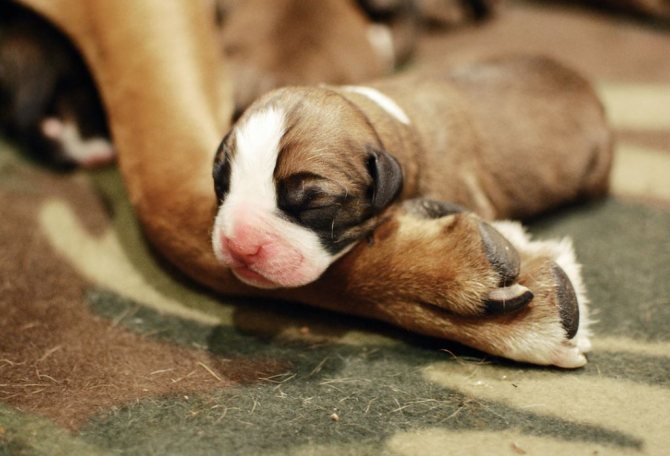
The eyelids finally develop in the following weeks after the puppy is born. Lack of vision after 20 days already indicates the presence of any problems or even congenital defects. Also, the eyes may not open due to the development of conjunctivitis, due to accumulated dirt on the eyelashes, or due to the fact that microbes are trapped between the eyelids.
Sometimes, even when vision appears, puppy eyes stick together quite tightly, and attempts to open them can be very painful for the baby. There is also discharge of pus from the eyes. You can prevent problems from arising by treating them with strong tea leaves, chamomile decoction, antibiotic drops or furatsilin.
We advise you to read: Why does a dog smell?
To make a chamomile decoction, you need to brew the prepared packet with boiling water for 30 minutes. Or pour a teaspoon of the mixture into a glass of water and simmer over low heat for 10 minutes. The broth should be cooled to approximately a temperature that is a couple of degrees higher than body temperature.
If a mother diligently cares for her newborn babies, then the owner, in fact, will not need to provide additional care. Since a caring mother licks her babies, removing excess secretions and thereby helping the natural opening of the organs of vision.
When does a child begin to focus his gaze?
At 7 months of pregnancy, the fetal vision is almost completely formed. What remains is the development of the brain center responsible for visual perception, which begins to process pictures from 4 months of age after the birth of a child. Therefore, up to four months, babies can see the world only in a two-dimensional image. From this age, the toddler is able to focus his gaze on stationary and moving objects.
How newborns see objects has been known for a long time; all children develop according to a standard scenario. After childbirth, due to compression of the skull, swelling and swelling of the eyelids, the baby perceives the surrounding space vaguely. Closer to one month of age, the baby sees objects in black and white. As they grow, their arsenal of visual perceptions is replenished with a variety of colors, first with red and yellow at the age of about 3 months, later with green, blue and other tones.
How do babies see at 1 month?
Parents are often interested in how one-month-old newborns see, how can they understand that the development of visual perception is developing normally? At 1 month, the main objects that the baby distinguishes are sources of bright light and the mother’s face. The baby's eyes wander around the room because it is still difficult for him to focus his gaze on surrounding objects.
What colors does a baby distinguish at 2-3 months?
At the age of two months, the child, in addition to white and black, begins to distinguish red, orange and yellow colors. A three-month-old toddler already follows moving objects with his eyes, perceives the absence and presence of light. But it cannot yet capture the visual image in wide format. A 2-3 month old baby sees all surrounding objects in two-dimensional space. A newborn child begins to see normally from about five months of age.
Improving visual function from 4 to 6 months
After three months, starting from the fourth, green and blue are added to the palette of colors that babies distinguish. The visual parts of the brain and the central zone of the retina of a child at 4–6 months provide the ability to see a three-dimensional image with many shades of colors. Babies at this age are actively exploring the world around them, looking at objects. Toddlers turn their heads in all directions and can fix their gaze on both stationary and moving objects.
Fetal development of vision: when do babies begin to see?
Parents' hearts are bursting with joy as they watch their children open their wide and curious eyes. Have you ever wondered how those eyes can see around when your baby is still inside your tummy?
The eyes are the most incredible organ of the human body. It is not surprising that they develop for a very long time and continue this process even after birth.
It all starts with a few cells, multiplying, they form two optic nerves, and others form the lens of the eye. This occurs in the 4th week of pregnancy. By the 16th week, the baby's eyes become sensitive to light, but the eyelids still remain closed. They are fully formed by the 26th week - the baby opens his eyes and begins to blink, waking up in the womb.
According to researchers, having certain nutrients in your diet can have a positive effect on your baby's vision. For example, vitamin A is essential for eye development. Make a point of eating foods rich in vitamin A - green leafy vegetables, beef liver, carrots, sweet potatoes, eggs and dairy products.
Recent studies have shown that sunlight is beneficial for the eyes of an unborn baby. Of course, it's too dark in the womb. But, if you are in sunlight, some photons pass through the skin and tissue. If in doubt, try shining a flashlight on your tummy and feel the blow after blow.
The studies were conducted on pregnant mice kept in complete darkness throughout their pregnancy. Their pups were born with vision problems. This experiment explained the high risks of congenital eye diseases in children, women living in northern latitudes and becoming pregnant during the darker months of the year.
Pregnant women are advised to take certain precautions: when in the sun, use sunscreen 15 minutes before going outside and stay in the shade from 10 a.m. to 2 p.m.
Children's eyes are attractive, you never get tired of looking into them. Your baby's eyes and brain are still developing after birth, and you'll need to be patient while your baby coos and cooes back to you.
Shall we turn on some music to set the mood?
Now playing:
Open Kluber FM website | iOS app | Android app
Visit to an ophthalmologist
At one month of age, a mother with a baby can come to the clinic for the first time to see a pediatrician. During follow-up examinations, specialists check the physical and mental indicators of the child’s development. Certain reflexes indicate the correct development of a one-month-old baby. Normal speech progress is indicated by the child’s ability to communicate discomfort through a reflex cry. Visual skills at one month of age are limited to observing large, brightly lit objects.
Reflexes corresponding to a month-old child:
- Grasping - placing his finger on his palm, the little one will grab onto it.
- Search - barely touching the cheek, the baby will turn its head in search of the “stimulant”.
- Sucking - by running a finger near the lips, the baby will immediately begin to smack his mouth.
- Protective - placing the baby on his tummy, he should immediately turn his head to the side.
- Moro reflex - having slammed the surface where the baby is lying, he will immediately spread his arms and legs to the sides.
- “Automatic gait” reflex - if you put the child in a vertical position, holding him by the armpits, the child begins to confidently move his legs, imitating steps.
The vision analyzer in a one-year-old child, including the main visual organ (eyes) and the perceptive areas of the cerebral cortex, is fully formed. In addition to full visual perception, which can be confirmed by an ophthalmologist, a child at 12 months should crawl on all fours, sit confidently, actively master walking skills, know 10–15 words, and hold toys in his hands.
Why do you need a professional examination by a specialist every six months?
After the first six months of the baby’s life, it is imperative to show it to an experienced ophthalmologist.
A professional doctor will check the child’s eyes to see if they are healthy, have equal vision, visual acuity, and whether eye movements are symmetrical. A visit to the clinic will help make sure that the formation of the eyes is progressing according to the age period, and there are no factors that interfere with the development of the visual apparatus in the baby.
What signs should parents of a newborn pay attention to?
A child who can speak, if something bothers him, will definitely inform his parents about it. But when it comes to a newborn, adults will have to carefully observe the behavior of their child; this is the only way to notice in time suspicious symptoms of an incipient eye disease or visual impairment. Pathology can be suspected because the baby squints, rubs its eyes, and blinks frequently. Defects in the formation of the visual apparatus make themselves felt when the child bumps into interior objects, does not react to bright objects in front of his eyes, etc.
Alarming signs of abnormal development or disease of the baby's eyes:
- The size of the eyeballs should be appropriate for age. Any deviations from the norm, for example, bulging of one or both eyes, require immediate contact with a specialist.
- If a baby squints his eyes, this can lead to serious problems in the future. If you detect the slightest signs of strabismus, you must immediately show the baby to the doctor.
- Uncoordinated movements of the left and right eyes indicate abnormal development of visual functions or a congenital anomaly.
- Red, watery eyes in a baby may indicate an allergy, infection or other disease. With such a pathological condition, the child will need, in addition to being examined by an ophthalmologist, to undergo tests.
- The iris should ideally be the same color. In nature, there are cases when the right eye is one color, and the left is another, and at the same time a person sees perfectly. If a child's eyes are different in color, it is best to discuss this case with a doctor.
- The pupils must be perfectly round in shape and diameter. When directing light onto a baby's eyes, the normal reaction will be a narrowing of the pupils.
- From the first weeks of life, it is imperative to observe how newborns see objects, whether they can focus their gaze on stationary and moving objects.
How and when do puppies' eyes and ears open?

Dogs do not develop in parallel, and even if they are born in the same litter, they may not gain hearing and vision at the same time. In this case, it is important to take into account the nuances of the development of each individual individual. Often, the timing of eye opening in young dogs is influenced by the date of their birth. If the cubs are born post-term, they may begin to hear and see earlier than standard time.
On average, the process of acquiring vision takes 10-15 days. It usually starts with a small gap in the inner corner of the eye, which eventually moves to the outer corner. It happens that a gap appears in one of the eyes, and only later does it open completely, and it happens that the whole eye opens at once. The eyes will not always open synchronously - one may open first, and a few days later the other.
We advise you to read: Dog farts often - what to do?
Opening eyes does not mean good vision; its acquisition occurs after 3-4 days. Although it happens that the ability to see manifests itself on the first day. At the initial stage, the baby can only distinguish between light and darkness, then begins to see the outlines of objects nearby. Full vision in puppies, regardless of breed, usually begins from the 20th day of life.
The eyes appear cloudy and bluish at first, but after a couple of weeks they become clear and clear. Typically, the eyes become darker. In particular, most breeds have dark brown eye color.
In any case, even if the puppy’s eyes have not yet opened within the standard time frame, you cannot open them on your own. This can lead to damage not only to the lacrimal glands, but also to vision in general.
The ears begin to “work” much earlier than the eyesight – at about a week of age. But the full extent of hearing also does not appear immediately. So, at the age of 3 weeks the animal already reacts to loud sounds, and after a week its hearing will become even more acute.
While vision problems are easy to notice, it is much more difficult to understand that a dog has some degree of hearing loss. In any case, if at the age of one month the dog still does not show any reaction to sounds, then it is definitely worth contacting a veterinarian. For example, to test hearing in the earlier stages, you can snap your fingers on the side of the puppy's head or rustle with a plastic bag and track your pet's reaction.
When raising a purebred dog for exhibitions, and also if the owner simply wants to notice all the important stages in the pet’s life, then the date when the puppy’s eyes and ears opened, he should note along with other important dates, for example, the beginning of the use of complementary foods, etc. d.
Video
Vision is one of the most important human organs. Along with smell, touch, hearing, taste, and the vestibular system, vision allows you to receive, analyze incoming information and adapt to the world around you. Human vision begins to form in the third week during intrauterine development, but at birth it does not yet allow one to see even a hundredth of what an adult sees.
The vision of a newborn, in particular, the visual centers and the retina of the child’s eye are not fully formed. His world is gray with shades of light and dark. He still vaguely sees his mother, but he knows her smell and voice. Therefore, it is recommended to bring your face closer to the baby so that he can see him in all details.
There is no need to move further than 40 cm. Studies conducted on vision in newborns and its development have shown that when choosing what to look at - a face or a picture - the child always chooses the face, especially the mother’s face.
After discharge from the hospital, parents and all adults carefully examine the new family member. What kind of arms, legs, mouth and nose he has, but what interests everyone first of all are his eyes. The baby looks, but his gaze wanders, stopping only at his mother, and only if she is close. His eyes can look in different directions, and this often frightens parents. However, there is nothing to worry about. At the maternity hospital, the newborn's vision has already been checked by an ophthalmologist.
Medical examination
A medical examination consists of checking the pupils, their size, symmetry, and reaction to light.
The doctor must check your vision, examine the fundus, the state of visual functions, and tear ducts. If he detected any deviations from the norm, he would take appropriate action.
During the examination, the doctor checks the child's pupils, their size and symmetry, as well as their reaction to light.
During the visit, the doctor may discover defects that can be easily eliminated. For example, the tear ducts are underdeveloped or a birth injury causes strabismus. But there may also be serious pathologies that need to be eliminated as early as possible. Congenital glaucoma, cataracts or retinopathy in premature babies can seriously affect the developmental stages of vision and the entire body.
To know for sure that everything is fine with the baby, the head physician of the Sfera ophthalmology clinic, Professor E. N. Eskin, recommends showing the baby to the ophthalmologist three times in the first year of life: in the first month, at six months and at one year.
The need for specialist consultation
If you notice any deviations in the development of not only vision, but also other functions of the newborn’s body, tell your local pediatrician about your concerns, and he will give you a referral to the right specialist.
Observe the child to see if he can easily follow a moving object in the first months of life or if this is difficult for the baby. Sometimes the whites of the eyes turn red, discharge appears in the corners of the eyes, they “sour”, tears drip from one or both eyes, and squint appears in the eyes. All these signs require immediate consultation with a specialist.
It is necessary to warn worried parents, and especially grandparents, that almost all problems are solved and vision is restored. Don't forget, too, that many vision problems in infants occur for psychological reasons. If there is constant screaming and scandals in the child’s family, the child’s vision may deteriorate in order to “not see” the bad environment, lack of love, and disrespect for each other. Mutual love and respect between adults in the family becomes a support for the child throughout his life.

